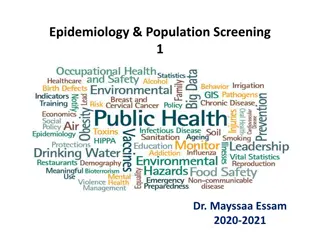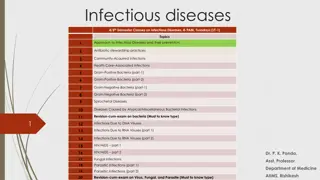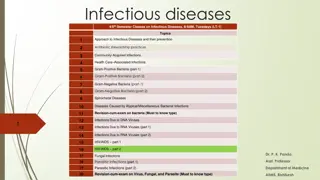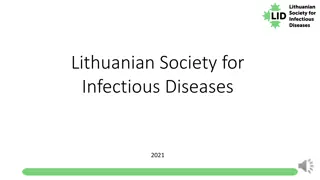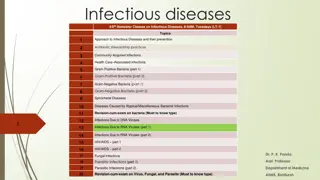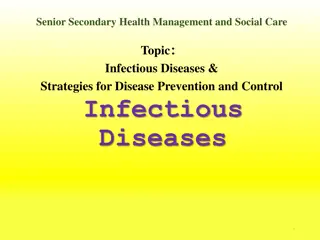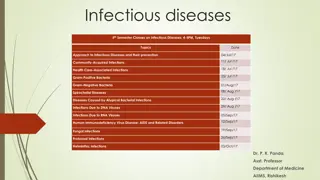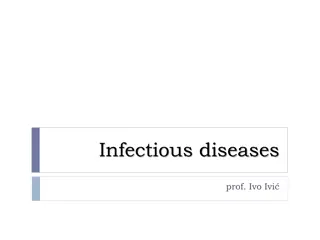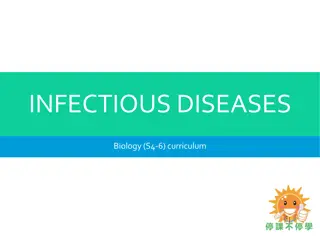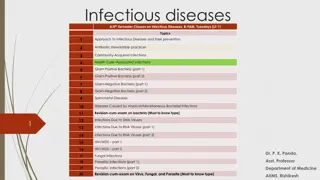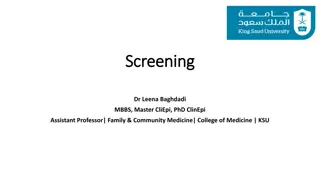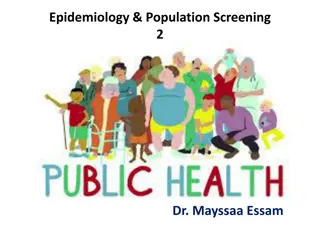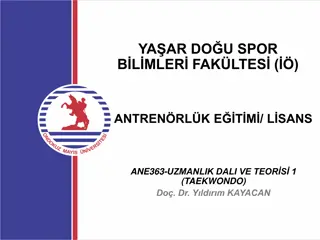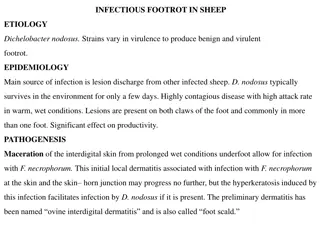Epidemiology & Population Screening: Infectious Diseases and Development
Epidemiology of communicable and non-infectious diseases, control of infections, antimicrobial resistance, disease surveillance, impact of environmental changes on disease patterns, components of communicable diseases, infectious agents, reservoirs of infection, human reservoirs, carriers.
Download Presentation

Please find below an Image/Link to download the presentation.
The content on the website is provided AS IS for your information and personal use only. It may not be sold, licensed, or shared on other websites without obtaining consent from the author.If you encounter any issues during the download, it is possible that the publisher has removed the file from their server.
You are allowed to download the files provided on this website for personal or commercial use, subject to the condition that they are used lawfully. All files are the property of their respective owners.
The content on the website is provided AS IS for your information and personal use only. It may not be sold, licensed, or shared on other websites without obtaining consent from the author.
E N D
Presentation Transcript
Epidemiology & Population Screening 2 Dr. Mayssaa Essam 2021-2022
Infectious diseases and development Epidemiology of communicable diseases. Control of communicable diseases The use of drugs in the control of infections Antimicrobial resistance Surveillance of disease Epidemiology of non-infectious diseases Changes in land and water use, deforestation, agricultural development, dams and irrigation schemes can have major positive or negative impact on the pattern of disease .Large outbreaks?? of communicable diseases periodically occur worldwide.
EPIDEMIOLOGY OF COMMUNICABLE DISEASES THE COMPONENTS OF COMMUNICABLE DISEASE Communicable diseases are characterized by the existence of a living infectious agent which is transmissible. Apart from the infectious agent, two other factors, the host and the environment, affect the epidemiology of the infection. The relationship between these three components may be illustrated using the following analogy: Agent: The seed Host: The soil Route of transmission: The climate
INFECTIOUS AGENTS These may be viruses, rickettsiae??, bacteria, protozoa, fungi or helminths??. The biological properties of the agent may play a major role in its epidemiology. In order to survive an infectious agent must be able to do the following: multiply. emerge from the host. the mechanisms that the organism uses at each of these four stages may help in identifying the most weak stage at which to direct control measures. The ability of the infective agent to survive in the environment is an important factor in the epidemiology of the infection.
Reservoir of infection This term is used to describe the specific ecological niche upon which it depends for its survival. The reservoir may be human, animal or non-living material. The infective agent lives and multiplies in the reservoir from which it is transmitted to other habitats but cannot survive indefinitely at these other sites. For example, from its human reservoir, Salmonella typhi the cause of typhoid fever, can contaminate water supplies, milk and other food products and can infect susceptible hosts. Since the bacilli cannot survive indefinitely in these habitats, these other sites do not represent the reservoir of typhoid infection but may serve as a source of infection.
HUMAN RESERVOIR This includes a number of important pathogens that are specifically adapted to man the infective agents of measles, AIDS, typhoid, meningococcal, meningitis, gonorrhoea and syphilis. The human reservoir includes both ill persons and healthy carriers. In some cases (e.g. salmonellosis) humans share the reservoir with other animals. Carriers A carrier is a person who harbours the infective agent without showing signs of disease but is capable of transmitting the agent to other persons. Different types of carriers are described depending on when they excrete the organism in relation to the illness:- A healthy carrier :-remains well throughout the infection.
An incubatory or early carrier:- excretes the pathogens during the incubation period, before the onset of symptoms (e.g. HIV/AIDS) or before the characteristic features of the disease (e.g. the measles rash or glandular swelling in mumps) are manifested (appeared). A convalescent carrier:- continues to harbour the infective agent after recovering from the illness. The carrier may excrete the agent for only a short period; or may become a chronic carrier, excreting the organism continuously or intermittently over a period of years. WHY CARRIERS ARE IMPORTANT IN THE EPIDEMIOLOGY OF SOME INFECTIONS? Carriers play an important role in the epidemiology of certain infections (meningococcal meningitis&typhoid):-
There may be large numbers of carriers far out numbering the sick patients. Since neither the healthy carriers nor their contacts are aware of the infection, they may not take care to avoid transmission of the infection Chronic carriers may serve as a source of infection over a very long period and as a means of repeatedly reintroducing the disease into an area which is otherwise free of infection. ANIMAL RESERVOIR Some infective agents that affect humans have their reservoir in animals. The term zoonosis is applied to those infectious diseases of vertebrate animals which are transmissible to man under natural conditions:-
where humans use the animal for food. where there is a vector transmitting the infection from animals to humans, e.g. plague (flea),viral encephalitis (mosquito); where the animal contaminates human environment including food, e.g. salmonellosis. Health workers should collaborate closely with veterinary authorities in identifying and dealing with these zoonoses. NON-LIVING RESERVOIR Many of these agents are saprophytes living in soil and are fully adapted to living free in nature. The vegetative forms are usually equipped to withstand marked changes in environmental temperature and humidity. In addition, some develop resistant forms such as spores which can withstand adverse environmental conditions, for example clostridial organisms the infective agents of tetanus (Clostridium tetani), gas gangrene botulism(C. botulinum).
THE SOURCE OF INFECTION This term refers to the immediate source of infection; that is, the person or object from which the infectious agent passes to a host. This source of infection may or may not be a portion of the reservoir. For example, human beings are the reservoir of shigella infection; a cook who is a carrier may infect food that is served at a party; that item of food, rather than the reservoir is the source of infection in that particular outbreak. ROUTE OF TRANSMISSION This refers to the mechanism by which an infectious agent is transferred from one person to another or from the reservoir to a new host. Transmission may occur by:
Contact, either directly, person to person, or indirectly through contaminated objects Contact infections are more likely to occur where there is overcrowding, since this increases the likelihood of contact with infected persons. Penetration of skin, directly by the organism itself (e.g. hookworm larvae, schistosomiasis), by the bite of a vector (e.g. malaria) or through wounds (e.g. tetanus). Inhalation of air-borne infections. Poor ventilation, over-crowding in sleeping quarters and in public places are important factors in the epidemiology of air-borne infections. Ingestion, from contaminated hands, food or water.
Transplacental infection. Some infective agents cross the placenta to infect the fetus in the womb, producing congenital infections (e.g. HIV, syphilis, toxoplasmosis). For some infective agents, infection occurs through more than one route of transmission. For example, plague is transmitted by flea bite but in some cases, direct person to person transmission occurs through the respiratory route (pneumonic plague). HOST FACTORS The occurrence and outcome of infection are in part determined by host factors. The term immunity is used to describe the ability of the host to resist infection. the Resistance to infection is determined by non-specific and by specific factors.
Non-specific resistance This depends on the protective covering of skin which resists penetration by most infective agents, and the mucous membranes, some of which include ciliated epithelium which mechanically scavenges particulate matter. Certain secretions mucus, tears and gastric secretions contain lysozymes??? which have antibacterial activity; in addition, the acid content of gastric secretion also has some antimicrobial action. Reflex responses such as coughing and sneezing also assist in keeping susceptible parts of the respiratory tract free of foreign matter. If penetration has occurred, the organisms may be eliminated through the actions of macrophages?? and other immue cells or through the effects of non-specific serological factors.
Specific immunity Specific immunity may be due to genetic or acquired factors. GENETIC FACTORS Specific genetic factors have been associated with resistance to infection, for example persons who have haemoglobin S??? are more resistant to infection with Plasmodium falciparum than those with normal haemoglobin AA????. There are also variations in the susceptibility of various races and ethnic groups, for example some people of African origin tend to have a high level of resistance to vivax malaria infection.
ACQUIRED FACTORS Acquired immunity may be active or passive, Inactive immunity the host manufactures antibodies and develops other protective mechanisms including cellular immunity????? Active immunity may be naturally acquired following clinical or subclinical infection; or it maybe induced artificially by administering living or killed organisms or their products. In passive immunity, the host receives preformed antibodies. The new-born baby acquires passive immunity by the transplacental transmission of antibodies; in this way the newborn babies of immune mothers are protected against such infections as measles, malaria and tetanus in the first few months of life. Passive immunity is artificially induced by the administration of antibodies from the sera of immune human beings( homologous)??? or animals (heterologous) ??????.Protection from passive immunity tends to be of short duration, especially when heterologous serum is used. https://meet.google.com/rkg-ewdx-ode
Test Comper:- 1- Hemoglobin A and hemoglobin B. 2- Spores and vegetative forms. 3- Active or passive immunity and inactive immunity.
REFERENCES Rowitz, Louis. 2008. Public Health Leadership: Putting Principles into Practice. A d e t o k u n b o O . L u c a s&H e r b e r t M . G i l l e s. 2003. Short Textbook of Public Health Medicine For the Tropics 4th edition Epidemiology is fundamentally engaged in the broader quest for social justice and equality.


